Celes and Susan Davar: Living with a Low Footprint
31 Jan 2025
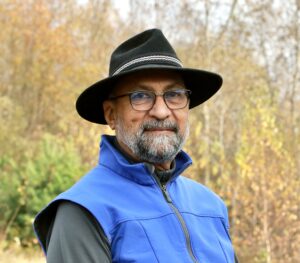 Celes Davar grew up in Fredericton, on a street bookended by an apple orchard. “The smell of Wabanaki [forest] is embedded in me,” he says. After discovering ecology at the University of New Brunswick, he was hired by Parks Canada in 1974: first as a naturalist in Cape Breton Highlands National Park and then as an interpretive planner throughout Atlantic Canada. He reflects on the evolution of the broader conversation about nature preservation since that time; “it was a more privileged perspective about my own love of nature and fulfilling my love of being involved in active nature preservation,” not informed by the frameworks of colonialism and the settler approach that have since come more prominently into focus, and shifting our understanding of how ecosystem protection, traditional knowledge, and indigenous knowledge intersect.
Celes Davar grew up in Fredericton, on a street bookended by an apple orchard. “The smell of Wabanaki [forest] is embedded in me,” he says. After discovering ecology at the University of New Brunswick, he was hired by Parks Canada in 1974: first as a naturalist in Cape Breton Highlands National Park and then as an interpretive planner throughout Atlantic Canada. He reflects on the evolution of the broader conversation about nature preservation since that time; “it was a more privileged perspective about my own love of nature and fulfilling my love of being involved in active nature preservation,” not informed by the frameworks of colonialism and the settler approach that have since come more prominently into focus, and shifting our understanding of how ecosystem protection, traditional knowledge, and indigenous knowledge intersect.
He eventually landed in Manitoba, where he spent 17 years as the Chief Naturalist, and later the Visitor Services Manager for Riding Mountain National Park. “I learned that while not everyone shared my passion for ecosystem preservation, that there were many others who had common interests about conservation of lands and species. How do you communicate preservation values and ecological science to others who may see nature as being more utilitarian and resource based rather than a set of human practices that we can collectively adopt to help us live in harmony with nature’s principles, and thrive as a species?” Having honed his passion and skills for communicating about nature and the impacts of climate change, he reoriented his professional work around experiential tourism, storytelling, and why storytelling has community value and value for visitors seeking unique ways to experience nature, culture, and communities in their travels.
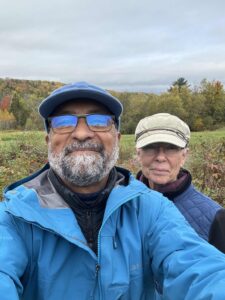
Sue and Celes Davar beside the forest. South Mountain, Gaspereau Valley.
Celes and his wife Sue (who shares a deep appreciation for nature) returned to Nova Scotia in 2017 to re-settle in the province that they had first moved to after their university education. Celes explains that this led them to the Annapolis Valley to look for a place to build their new home: “We met a real estate agent in Kentville and gave him our criteria. We love rural Nova Scotia, and the Wolfville area has always appealed to us.” Three weeks after they returned to Manitoba, the agent emailed them about a property outside Wolfville. It was more land than they had envisioned. But their son Naryn immediately visited the land and sent them a video of the forest and fields with the message, “I don’t think you can afford not to buy this.”
Naryn had just completed a master’s degree in architecture at Dalhousie and was deeply committed to energy efficiency in housing design. He designed a Passive House for Celes and Sue on the new property, as an employee with the Halifax architectural firm Passive Design Solutions. Their house became part of the company’s catalogue and was named “The Glengarry.” On top of its extreme energy efficiency, it’s designed for Celes and Sue to age in place; they also added a solar system and a similarly energy efficient outbuilding to serve as an office as well as Sue’s pottery studio. For Celes and Sue, the move “has fulfilled a lifetime of commitment to living with a low footprint. And we’ve learned that designing a Passive House for energy efficiency also means that we are living in a house that is strongly hurricane, wildfire, and intense rainstorm resilient.”
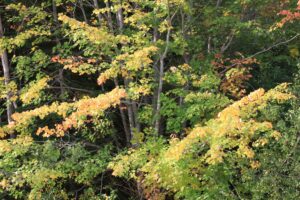
Red maples turning colour into reds and yellows in the West Brooklyn Wabanaki forest. Photo copyright: Celes Davar.
But the 84 acre property was far more than just the place for the house and office/studio. At first, they were happy to simply have purchased forested habitat to keep under their own private protection. Since then, Celes and Sue have established a deep relationship with the forest and its biodiversity. Now they are working with the Nova Scotia Working Woodlands Trust to formalize a conservation easement agreement for 72 acres of Wabanaki forest on the land, giving it legal protection in perpetuity. This remarkable patch of forest includes White Pine, Eastern Hemlock, Red Maple, Yellow Birch and White Ash. It is home to species at risk such as Eastern Wood-Pewee. As well, their trail cameras have shown that a wide range of small and large mammals, Barred Owls, and species like Blackburnian warblers (nesting in hemlocks), Broad Winged Hawks, and many species return to nest here annually.
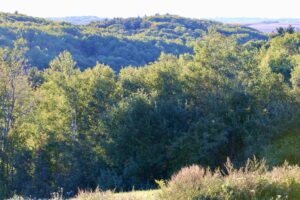
Wabanaki Forest, West Brooklyn. Photo Copyright Celes Davar.
Taking this step is not only a personal fulfillment. It’s also intrinsically related to the work that Celes has been doing for almost 30 years through his company Earth Rhythms, which has become a leader in what is called ‘Experiential Tourism.’ “I work in many rural communities throughout Canada where there are people willing to invest in bringing community stakeholders together to uncover the stories that are present within the local ecosystem, and then help them to create legendary visitor experiences that are quite different from conventional tourism tours and itineraries.” These experiences reflect slow travel, are for small groups, and include commitment to regenerative practices, low waste, and giving back to the community as part of their approach. Through his Earth Rhythms work, Celes’ goal is to help communities cultivate a responsible tourism approach that is not transactional nor exploitive – but rather a force for good. “We want to transform our guests by inviting them into experiences,” he explains. “The goal is that people go back home changed as a result of what they learned, what they did, and who they met as guides and facilitator. When they return, they advocate for the people and places that they have just visited.” And for Celes, the connection to place always necessarily includes connection to nature. Recently, he has been coaching the development of a whole suite of new experiences with community hosts in the Annapolis Valley called FoodArtNature.
The commitment to forest protection and supporting localized regenerative tourism is where Celes’ connection to the Nature Trust comes in. “I began supporting carbon offsets maybe 12 or 15 years ago, as a way of offsetting my air travel,” he says. “In the early days of carbon offsets, the concept and intentions were good. However, as we have learned, the focus became primarily on one small method of carbon reduction through travel, offsetting with fees to help restore damaged ecosystems in other parts of the world, or to financially support renewable energy investments and infrastructure in other countries. I began asking myself some questions about whether this was the best use of our desire to offset the carbon cost of our travels. Was supporting a project in Madagascar something I’m interested in, when I know there is so much that we need to be doing here in Nova Scotia to both protect habitat and restore damaged ecosystems?” After participating in a one-year pilot project to use their own forest in a carbon market, Celes began to research whether any provincial organizations were supporting carbon offset mechanisms and, more broadly, how to account for the carbon cost of travel in a different way.
He became aware of the Nature Trust’s work along the Eastern Shore and was impressed by the results. “That’s when it clicked,” he says. “The Nature Trust actually bought habitat that already exists. This is what is needed to help Nova Scotia meet is protected areas goals, and what is necessary to help sustain nature and people in this province for the long term. The Nature Trust actually had a plan, and they carried it out, working with Nova Scotians to systematically purchase vital habitat. I thought, why don’t I just make a donation to the Nature Trust every time I travel, in lieu of a carbon offset, in recognition of our choice to travel, and the carbon consequences of that?” Since then, for every flight he has taken over the past decade, Celes calculates his emissions with an online calculator, converts it into a financial contribution, and makes a corresponding donation to the Nature Trust. Each time he and Sue travel, they donate more than what the online calculator suggests (which is less than the cost of one person going out for a modest supper).
“What I like about what the Nature Trust is doing, is purchasing habitat that already sequesters carbon and protects existing biodiversity. That was a significant shift in thinking and financial actions, for us. We have been donating 1% of our gross revenues as a business for the past two decades to causes that are action-oriented and support social and environmental issues. Donations to the Nova Scotia Nature Trust have become part of how we reinvest into habitat protection and legacy lands for this province.” He shares this approach with his tourism colleagues across Canada, asking them to think about identifying local organizations that a small portion of the revenues from their tourism experiences could support. He has been pleasantly surprised that there has been no push-back. Tourism business owners understand the importance of giving back to nature and community initiatives where they live.
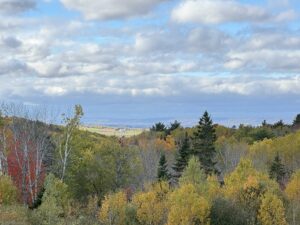
West Brooklyn Wabanaki Forest. Photo: Celes Davar
“These are mechanisms to recognize and invest into our communities and landscapes, where we have a long-standing relationship with place. Our job is to recognize that nature protection, reducing carbon emissions and poverty, lack of access to housing, racism, capitalism, settler colonialism – all of these intersect. We can intervene as donors and help to reduce the negative impacts somewhat.”
On January 26 of this year Celes was awarded a 2025 IMPACT Sustainable Tourism award in Victoria, which celebrates individuals and organizations who inspire and lead in creating positive impacts for communities, the economy, and the environment.
Please join us in thanking Celes for sharing his story! Learn more about the Nature Trust’s work to protect Wabanaki forest, or learn about the other conservation priorities that your support makes possible.
